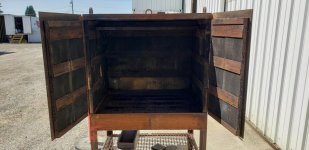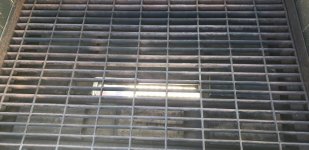eqshop9689
Plastic
- Joined
- Aug 31, 2017
So i have this huge beefy heavy steel cabinet that is lined with fire bricks, i think they may have used to preheat certain types of parts for welding cracks up for example cracks in cast iron, like an exhaust manifold. it doesn't have any forced air, so the highest temp i can achieve with the doors shut is around 400-500 before it runs out of air.
My goal is to do some heat treating for parts, for example i have some 1018 cold rolled that i want to pack carburize, which calls for 1800 degrees for 8 hours. What do i need to add to this setup to get to that temp for 8 hours.
i know i will need some sort of forced air. the bottom of the kiln has a 2" by 10" slot it in... no other openings.
there are four horizontal tubes with small holes that act as the burners
Most of the blacksmithing forges force air in with the fuel, either a ventrui or a blower fan of some sort.
I dont think the way that my burners are setup that i could do that.
i am thinking that i would need some sort of adjustable blower motor on the bottom of the kiln, and then some sort of adjustable stove pipe on top?
also trying to figure out how much propane that would require to maintain 1800 degrees for 8 hours.
see attached pictures, any input is greatly appreciated





My goal is to do some heat treating for parts, for example i have some 1018 cold rolled that i want to pack carburize, which calls for 1800 degrees for 8 hours. What do i need to add to this setup to get to that temp for 8 hours.
i know i will need some sort of forced air. the bottom of the kiln has a 2" by 10" slot it in... no other openings.
there are four horizontal tubes with small holes that act as the burners
Most of the blacksmithing forges force air in with the fuel, either a ventrui or a blower fan of some sort.
I dont think the way that my burners are setup that i could do that.
i am thinking that i would need some sort of adjustable blower motor on the bottom of the kiln, and then some sort of adjustable stove pipe on top?
also trying to figure out how much propane that would require to maintain 1800 degrees for 8 hours.
see attached pictures, any input is greatly appreciated






